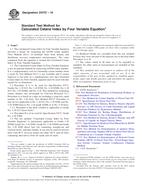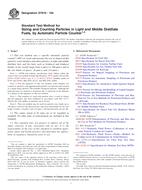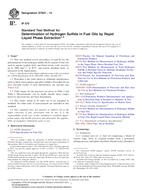Potřebujeme váš souhlas k využití jednotlivých dat, aby se vám mimo jiné mohly ukazovat informace týkající se vašich zájmů. Souhlas udělíte kliknutím na tlačítko „OK“.
ASTM D4737-10
Standard Test Method for Calculated Cetane Index by Four Variable Equation
Automaticky přeložený název:
Standardní zkušební metoda pro Vypočítaná cetanového indexu čtyři proměnné rovnice
NORMA vydána dne 1.8.2010
Informace o normě:
Označení normy: ASTM D4737-10
Poznámka: NEPLATNÁ
Datum vydání normy: 1.8.2010
Kód zboží: NS-28370
Počet stran: 5
Přibližná hmotnost: 15 g (0.03 liber)
Země: Americká technická norma
Kategorie: Technické normy ASTM
Kategorie - podobné normy:
Anotace textu normy ASTM D4737-10 :
Keywords:
cetane, cetane index, diesel fuel, Calculated Cetane Index (CCI), Density--petroleum products, Distillate fuels, Distillation--petroleum products, Four variable equation, Fuel oils, Nonpetroleum derivatives (of fuel), Shale, Tar sands, ICS Number Code 75.160.20 (Liquid fuels)
Doplňující informace
| Significance and Use | ||||||||||||||||||||
|
The Calculated Cetane Index by Four Variable Equation is useful for estimating ASTM cetane number when a test engine is not available for determining this property directly and when cetane improver is not used. It may be conveniently employed for estimating cetane number when the quantity of sample available is too small for an engine rating. In cases where the ASTM cetane number of a fuel has been previously established, the Calculated Cetane Index by Four Variable Equation is useful as a cetane number check on subsequent batches of that fuel, provided the fuel's source and mode of manufacture remain unchanged. Note 2—Test Methods D6890 and D7170 may be used to obtain a Derived Cetane Number (DCN) when the quantity of sample is too small for an engine test. These methods do measure the effect of cetane improver. Within the range from 32.5 to 56.5 cetane number, the expected error of prediction of Procedure A of the Calculated Cetane Index by Four Variable Equation will be less than ±2 cetane numbers for 65 % of the distillate fuels evaluated. Errors may be greater for fuels whose properties fall outside the recommended range of application. |
||||||||||||||||||||
| 1. Scope | ||||||||||||||||||||
|
1.1 The calculated Cetane Index by Four Variable Equation provides a means for estimating the ASTM cetane number (Test Method D613) of distillate fuels from density and distillation recovery temperature measurements. The value computed from the equation is termed the Calculated Cetane Index by Four Variable Equation. 1.2 The Calculated Cetane Index by Four Variable Equation is not an optional method for expressing ASTM cetane number. It is a supplementary tool for estimating cetane number when a result by Test Method D613 is not available and if cetane improver is not used. As a supplementary tool, the Calculated Cetane Index by Four Variable equation must be used with due regard for its limitations. 1.3 Procedure A is to be used for Specification D975, Grades No. 1–D S15, No. 1–D S500, No. 1–D S5000, No. 2–D S15, No. 2–D S5000, and No. 4–D. This method for estimating cetane number was developed by Chevron Research Co. Procedure A is based on a data set including a relatively small number of No. 1–D fuels. Test Method D4737 Procedure A may be less applicable to No. 1–D S15, No. 1–D S500, and No. 1–D S5000 than to No. 2–D grade S5000 or to No. 4–D fuels. 1.3.1 Procedure A has been verified as applicable to Grade No. 2–D S15 diesel fuels. 1.4 Procedure B is to be used for Specification D975, Grade No. 2–D S500. 1.5 The test method “Calculated Cetane Index by Four Variable Equation” is particularly applicable to Grade 1–D S5000, Grade No. 1–D S500, Grade No. 2–D S5000 and Grade No. 2–D S500 diesel fuel oils containing straight-run and cracked stocks, and their blends. It can also be used for heavier fuels with 90 % recovery points less than 382°C and for fuels containing derivatives from oil sands and oil shale. Note 1—Sxx is the designation for maximum sulfur level specified for the grade. For example, S500 grades are those with a maximum sulfur limit of 500 ppm (μg/g). 1.6 Biodiesel blends are excluded from this test method, because they were not part of the datasets use to develop either Procedure A or B. 1.7 The values stated in SI units are to be regarded as standard. No other units of measurement are included in this standard. 1.8 This standard does not purport to address all of the safety concerns, if any, associated with its use. It is the responsibility of the user of this standard to establish appropriate safety and health practices and determine the applicability of regulatory limitations prior to use. |
||||||||||||||||||||
| 2. Referenced Documents | ||||||||||||||||||||
|
Podobné normy:
Historická
1.5.2014
Historická
1.12.2013
Historická
1.5.2013
Historická
1.12.2012
Historická
1.9.2010
Historická
1.6.2014
Doporučujeme:
Aktualizace technických norem
Chcete mít jistotu, že používáte pouze platné technické normy?
Nabízíme Vám řešení, které Vám zajistí měsíční přehled o aktuálnosti norem, které používáte.
Chcete vědět více informací? Podívejte se na tuto stránku.



 ASTM D7592-14
ASTM D7592-14 ASTM D7593-13
ASTM D7593-13 ASTM D7618-13
ASTM D7618-13 ASTM D7619-12b
ASTM D7619-12b ASTM D7620-10
ASTM D7620-10 ASTM D7621-14
ASTM D7621-14
 Cookies
Cookies
